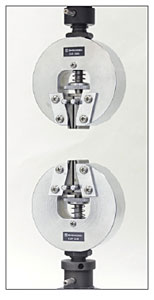5 kN Wedge Grips for Metal Specimens

Features:
- Specifically designed for testing thin metal plates and metal wires
- Grips have a maximum capacity of 5 kN (1,100 lbf)
- The wedge design enables quick exchange of specimens and applies a self-tightening action during testing
- Available with integrated parallel-grooved or embedded cross file-teeth grip faces
- Includes clamping tension adjustment via a spring mechanism
Relevant Materials:
Metals
Relevant Specimens:
Plates, Wires
These easily-operated wedge grips are for tensile testing thin metal plates and metal wires. Although these grips don't benefit from the stationary grip face feature of non-shift wedge grips, they still incorporate a wedge design, where the grip faces press against the wedged frame during testing, applying a self-tightening action to hold the specimen firmly in place.
There are two grip sets for 5 kN (1,100 lbf) wedge grips for metal specimens. Both grip sets include upper and lower grips. The difference between the two grip sets is one includes integrated parallel-groove grip faces whereas the other has embedded cross file-teeth grip faces. The grip faces are available separately, and can be interchanged with relative ease.
News / Events
-
AUTOGRAGH AGS-X2 Series has been released
The Shimadzu AUTOGRAPH AGS-X2 series provides superior performance and practical testing solutions for a wide array of applications. Offering high-level control and intuitive operation, the AGS-X2 series sets a new standard for strength evaluations while providing the utmost in safety considerations in a modern, stylish design.
-
AUTOGRAGH AGS-V Series has been released
Shimadzu Corporation released the Autograph AGS-V Series precision universal testing machine. In this series, the range over which the force measurement accuracy is guaranteed has been increased by a factor of two compared with existing machines. As a result of this new function, the work required to change force measurement sensors and accessories required for measurement can be reduced.
-
High-Speed Video Camera HyperVision HPV-X3 has been released
Recording speed of 20 million frames/second, the highest in its class provides larger, clearer, high-sensitivity recording. HPV-X3 is equipped with a synchronized recording function and high-level analytical capabilities that accommodate a variety of software programs.
-
New Video: AUTOGRAPH AGX-V2 Voice Operation Device XV-Talk
We will introduce how XV-Talk, the world's first voice control device installed in Shimadzu's latest tensile tester AGX-V2, can be used in various scenarios.
-
New Video: AUTOGRAPH AGX-V2 Operation Control Panel Stand-alone test feature
We will introduce a new feature of Shimadzu's latest tensile tester, AGX-V2, a stand-alone testing function using a large color LCD touch panel.
-
New Autograph AGX-V2 Series Precision Universal Testing Machines
The World’s First Testing Machines Equipped with a Voice Operation Device


